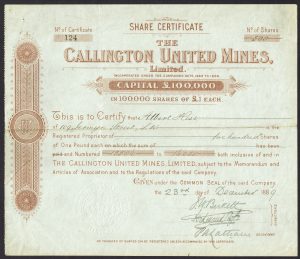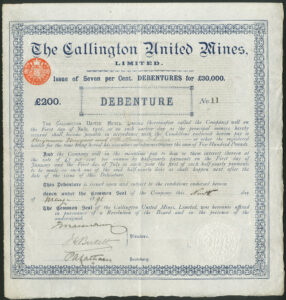| REF. NO. | DENOMINATION | DESCRIPTION | NO. ISSUED | CONDITION | VALUE |
|---|---|---|---|---|---|
 |
|||||
| 101 | £1 shares | 188[9], Brown | #123,#124,#149 | VF | £25-35 |
| 7% Debentures Authorised £30,000 |
|||||
 |
|||||
| 106 | £200 | 18[91], blue | #11 | VF | £25-35 |

Callington United Mines Ltd
Registered 10th of March 1888. Company number 26075. In voluntary liquidation 2nd of August 1892. Capital £100,000 in £1 shares. Tin, Copper, Arsenic and Tungsten mines at Kelly Bray, Callington, Cornwall, England.
1888
Description
Formed to acquire the properties of the New Holmbush Mining Co., Ltd. and the New Redmoor Mining Co., Ltd. at Kelly Bray, Callington, Cornwall. In total seven mines were taken over, Holmbrush, West Holmbrush, East Holmbrush, Kelly Bray, South Kelly Bray, Redmoor and the Emmens United Mines.
The prospectus advised that these mines had been significant producers of Tin, Copper and Arsenic previously and there was no reason that they would not be again. To aid with the production of Arsenic the company leased the Greenhill Arsenic works. It was also advised that there was a significant amount of Wolframite in the lodes which was increasing with depth and would become increasingly important to the mines. The prospectus may have been somewhat overstated which was typical for the time as it was also reported that there lead or on the properties that assayed 70-78% lead and contained 17-46 Oz of Silver per ton.
The company had intended to unwater the mines quickly and open up new ground at depth where it was thought the ore grade was improving. While this development work was being undertaken the old stopes where to be reworked. Operations did not start well for the company with the working capital subscribed to only being £26,937 rather than the £55,000 that had been hoped for. This combined with the mines being in a worse condition than thought so required greater expenditure on refurbishment the directors authorised the issue of the debentures to raise further funds.
Despite the raising of the new funds along with the revenue generated by reworking the old stopes, which for the first 6 months of 1890 raised £10,238, the company was still operating at a loss. The directors continued to give positive prospects for the mines but these never seem to have turned into actual results, it was resolved to wind up voluntarily as the company could no longer meet its liabilities by mid 1892.
